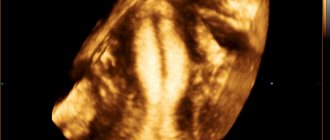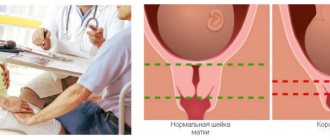Causes
Pathological tension in the muscular layer of the posterior wall of the uterus can occur due to the following factors:
- lack of progesterone, which, in turn, can occur with insufficient development of the genital organs, excessive production of male hormones (androgens), excessive production of the hormone prolactin;
- pathological changes in the uterine wall: fibroids, endometriosis;
- viral diseases (including influenza);
- high or low water levels;
- inflammatory diseases of the uterus and ovaries;
- negative impact of stress;
- overstretching of the uterine muscles, which occurs during multiple pregnancies or too much weight of the fetus;
- hard physical work;
- smoking, drinking alcohol.
important The likelihood of hypertonicity along the posterior wall also depends on the woman’s age: the risk of this disorder is increased if the expectant mother is under 18 years old or over 30 years old.
https://youtu.be/aebbPtPbB9w
How to avoid uterine tone
Before you start taking medications to normalize your condition, you should try to change your lifestyle. Sometimes this is quite enough to relieve hypertension and bring the general well-being of the expectant mother back to normal.
- The expectant mother should get proper rest every day. You cannot engage in physical labor, sports, or move for a long time without rest. A girl should get enough sleep, rest and relax. But at the same time you need to walk, breathe fresh air, swim, and do breathing exercises.
- Avoid lifting heavy objects, prolonged heavy loads and physical labor. All actions of the expectant mother should not cause discomfort. You can do light housekeeping, cooking, walking, pregnancy exercises and swimming.
- Reduce sexual activity. If a girl has been diagnosed with this, she will have to give up sex for a long time. Sexual activity can intensify pathological processes and lead to complications.
What to do if conventional methods do not help? If preventive measures do not produce positive results, the gynecologist prescribes medications to the woman to normalize her tone. Most often, drugs are prescribed in the form of suppositories. The dosage and course of use are determined by the attending physician.
Typically, in complex treatment, the following groups of drugs are prescribed:
- natural sedatives (valerian, motherwort, calendula);
- droppers with Magnelis B6;
- agents that reduce hypertension (Papaverine, No-shpa).
Self-medication is not recommended, as this is fraught with unpredictable consequences. Therefore, if the first symptoms of the disease appear, you should first consult a doctor. Perhaps the girl will be scheduled for a repeat ultrasound to find out how the fetus is developing. If there is no risk of complications, the gynecologist will give recommendations on how to normalize the condition and, if necessary, prescribe a course of medication.
What other causes of increased tone are there and how to prevent them are shown in the video:
Symptoms of hypertonicity of the posterior wall of the uterus
The development of hypertonicity of the posterior wall of the uterus is not always accompanied by the appearance of pronounced symptoms. In some cases, this disorder can only be detected by ultrasound. However, you can suspect the presence of hypertension if the following symptoms occur:
- pain in the uterine area;
- the appearance of pain in the lumbar spine;
- increased pain during physical activity or under stress;
- a feeling of tension (“petrification”) in the uterus, which can usually be felt in the last months of pregnancy.
dangerous With the further development of hypertonicity, bloody discharge from the genitals may appear, which is a very alarming symptom, so it is necessary to promptly identify signs of increased uterine tone and undergo the prescribed treatment in a timely manner.
What it is?
The uterus is a hollow muscular organ that can contract, and its basis is the myometrium.
During pregnancy, the uterus tends to enlarge. Nature arranges it in such a way that throughout pregnancy the muscle tissue of the uterus is in a relatively calm state. Thanks to this, it is possible to bear fruit. Also, the uterus can contract at times; this phenomenon occurs closer to childbirth. These abbreviations are called “training” abbreviations. It often happens that during pregnancy the muscle tissue of the uterus is in a tense state (uterine tone).
Diagnostics
The most common diagnostic method for suspected development of hypertonicity of the posterior wall of the uterus is ultrasound. Using this procedure, the doctor is able to assess the condition of the uterine walls, determine their thickness and possible tension in the muscle layer.
During the ultrasound, the specialist also determines the condition of the cervix in order to possibly detect signs of its shortening or opening of the pharynx.
If signs of hypertension are detected, the expectant mother may be recommended to undergo additional examinations , including a blood test to determine the level of progesterone and some other hormones.
In addition, an experienced doctor can determine the presence of hypertonicity by palpating the abdomen.
Treatment methods
After diagnostic measures, the doctor prescribes effective therapy, thanks to which it will be possible to maintain the pregnancy.
Who prescribes treatment?
If you experience unpleasant symptoms and suspect the development of pathology, you should contact your obstetrician-gynecologist. Thanks to his recommendations, it will subsequently be possible to prevent the development of a pathological process in the reproductive organ of a pregnant woman.
What medications are prescribed?
Mandatory therapy involves the use of sedatives. The most commonly prescribed medications are valerian or motherwort. If these drugs are ineffective, the specialist prescribes Nozepam.
If progesterone deficiency is responsible for the increased tone of the reproductive organ, the following drugs are prescribed:
Also, in most cases, patients are prescribed Magne B6, thanks to which they can compensate for the lack of vitamin B in the body.
Treatment with suppositories
Doctors usually prescribe Papaverine in suppositories. This is an effective remedy that has a beneficial effect on the pregnant woman’s body. In case of increased tone, it is recommended to use the drug according to the attached instructions.
Duration of treatment
The therapy provided depends on the nature and severity of the pathology. An experienced doctor determines the treatment period based on the patient’s condition and the diagnostic measures performed.
Methods for relieving hypertonicity of the posterior wall of the uterus
In case of sudden appearance of signs of hypertonicity along the posterior wall, it is advisable to take the following measures to prevent complications:
- refuse to perform any physical or mental activity, take a horizontal body position;
- relax the muscles of the body as much as possible, especially the muscles of the face;
- try to give the body a position in which the uterus will be in the most free position: for example, on all fours. In this position, you can perform several movements: for example, slowly arch your back while raising your head. After a few seconds, you can return to the starting position and repeat the exercise.
important In this case, you should definitely contact a medical institution to undergo an examination and prescribe medication.
Your doctor may recommend the following methods to eliminate signs of hypertension:
- taking hormonal medications if signs of deficiency of certain substances are detected;
- prescribing drugs that have a sedative (calming) effect;
- taking antispasmodics;
- prescribing medications containing magnesium (for example, a combination of magnesium and vitamin B6). This microelement helps normalize metabolism and eliminate excess tension of any muscle groups;
- compliance with bed rest.
How to relieve hypertension?
If you suddenly experience signs of hypertension, you need to take the following steps to prevent various complications:
- Avoid various types of stress, both physical and mental. You need to lie down and relax.
- Completely relax your body and facial muscles.
- Get on all fours, so your uterus will be free and your condition will significantly improve. You can perform these types of exercises: slowly arch your back and raise your head. Then you need to return to the starting position. The exercise must be repeated several times.
Dangers and complications
If you do not contact a medical facility in a timely manner and there is no effective treatment in the presence of signs of hypertonicity of the posterior wall of the uterus, the following serious complications may occur:
- a significant decrease in blood flow due to narrowing of the lumen of the uterine vessels under the influence of excessive tension in the muscle layer, which leads to fetal hypoxia;
- miscarriage: the risk of such a pregnancy outcome increases significantly in the first trimester, when the formation of the main systems and organs of the embryo (fetus) occurs;
- premature birth;
- dysfunction of the placenta, which can lead to its partial detachment.
information The likelihood of this disorder is significantly reduced if the expectant mother gets enough sleep at night, eats well, does not overexert herself physically, and avoids stress.
Since the risk of hypertension and the above complications increases significantly if a pregnant woman has a history of inflammatory diseases of the female genital organs or spontaneous miscarriages, in this case it is necessary to be especially careful about the appearance of possible symptoms of excessive tension of the uterine walls and regularly undergo prescribed examinations.
The uterus is a hollow muscular organ designed for the development and gestation of the fetus. For nine months it has been a warm and cozy home for the baby. Stretching and increasing in size tens of times during pregnancy, the uterus demonstrates excellent elasticity that no other organ possesses.
Pregnancy ends with the birth of a child, in which the uterus, which has high contractility, is directly involved. As a rule, before the onset of labor, the uterus of expectant mothers is in a relaxed state, with the exception of training contractions characteristic of the second half of the gestational age. Under the influence of unfavorable factors, the contractility of the organ increases, which leads to the appearance of local hypertonicity of the uterus during pregnancy. Why does the tone of the uterus increase earlier than expected? What is dangerous about local uterine hypertonicity during pregnancy, and how to prevent it?
Increased local tone of the uterus during gestation - normal or problem?
The wall of the uterus consists of layers:
- external serous (perimetry);
- middle muscular (myometrium);
- internal mucosa (endometrium).
The myometrium is composed of smooth muscle cells capable of contraction. Along with the growth of the fetus, there is an increase in the size of the uterus due to the development of myometrial cells. During the gestational period, each of the muscle fibers increases more than 10 times. Due to the presence of the muscular system, the uterus contracts during childbirth, putting pressure on the fetus and facilitating its expulsion.
IMPORTANT! The contractility of the uterus is influenced by the amount of actyosin, a protein that is responsible for the functioning of muscle fibers. It has been proven that the uterus has partial automatism, that is, it is capable of contracting reflexively, regardless of the connection with the brain.
No matter how strange it may sound, the uterus contracts because it has this ability. In response to any irritant, for example, a full intestine or bladder, stress, sexual arousal, the myometrium contracts, resulting in local hypertonicity of the uterus during pregnancy.
The degree of risk with increased uterine tone depends on the duration of pregnancy and accompanying symptoms. At short periods of gestation, hypertonicity of the myometrium is often the cause of termination of pregnancy, and therefore is regarded as a life-threatening condition for the fetus.
An increase in tone in the second half of the gestation period causes a disruption of blood supply in the uterus with the development of intrauterine fetal hypoxia.
Towards the end of pregnancy, local hypertonicity of the uterus is not dangerous, as it is one of the precursors of childbirth.
Why does the tone of the uterus increase during pregnancy?
1. Hormonal imbalance
- Low progesterone levels;
- Hyperandrogenism;
- An increase in the hormone prolactin, a progesterone antagonist.
2. Gynecological diseases
- Infantile uterus (underdevelopment of the female genital organs);
- Endometriosis;
- Uterine fibroids;
- History of infertility;
- Inflammatory processes of the pelvic organs;
- Previous operations (abortion, caesarean section).
3. Overstretching of the uterine walls (multiple pregnancy, polyhydramnios)
4. Emotional and physical stress
- Physically hard work;
- Irregular work schedule;
- Frequent business trips.
5. Infections (pneumonia, pyelonephritis, acute respiratory infections, influenza, etc.)
6. Smoking and drinking alcohol.
Symptoms of local hypertonicity of the uterus during pregnancy.
If the uterus is in increased tone, the expectant mother begins to complain of nagging pain in the lower abdomen or lumbar region. On palpation, the uterus is elastic, “stony”. The appearance of spotting bloody discharge from the genital tract indicates a threat of miscarriage.
IMPORTANT! Local hypertonicity of the uterus during short-term pregnancy can cause spontaneous abortion. Contraction of the myometrium leads to partial detachment of the ovum and disruption of the blood supply to the embryo.
Local myometrial hypertonicity is manifested by tension in a certain area of the anterior or posterior wall of the uterus.
Signs of hypertonicity of the anterior (vesical) surface of the uterus during pregnancy:
- nagging pain in the lower abdomen;
- discomfort in the perineal area;
- bloody discharge from the genital tract.
Signs of local hypertonicity of the uterus during pregnancy along the posterior (intestinal) surface:
- minor nagging pain in the lower abdomen;
- feeling of heaviness in the lumbar region;
- feeling of fullness in the perineum and rectum.
As a rule, the intensity of pain is similar to menstrual pain. It should be remembered that spotting during pregnancy in any quantity is the main sign of a threatened abortion.
IMPORTANT! The second half of pregnancy is characterized by an increase in uterine tone - the appearance of Braxton Hicks training contractions, which gradually prepare the uterus for childbirth. Training contractions are normal and are not accompanied by pain.
Diagnosis of local hypertonicity of the uterus during pregnancy.
One of the most reliable methods for diagnosing changes in myometrial tone is ultrasound. An increase in uterine tone is determined in the form of total or local tension of the myometrium.
IMPORTANT! During gestation, ultrasound of the uterus using a transvaginal sensor is not performed.
A woman can easily assess the tone of the uterus at home. To do this, you need to lie on your back and bend your knees. The muscles of the abdominal wall are relaxed in this position, which allows you to assess the tone of the uterus. With increased tone, the uterus is hard and protrudes in the form of a tubercle.
Local hypertonicity of the uterus during pregnancy. Prevention and treatment.
At the first signs of increased myometrial tone, you should immediately consult a doctor. Treatment of uterine hypertonicity should be carried out in a hospital setting.
If you are unable to seek medical help, you can try to relieve the tone of the uterus at home.
Medicines:
- antispasmodics (“No-shpa” - 2 tablets once, rectal suppositories “Papaverine”);
- sedatives (valerian tincture, Persen).
Horizontal position. Lie down on the bed and do not get up unless absolutely necessary. Before resting, empty your bladder, which also puts pressure on the uterine wall.
To prevent local increase in uterine tone during pregnancy, the following methods are used:
- stroking the belly: stroke the belly in a circular motion for 15 minutes in the morning and evening; the abdominal and uterine muscles should be relaxed at this time;
- wearing a bandage (from the second half of pregnancy): supports the uterus, reducing the load on the abdominal press;
- taking a bath (not hot!): warm water helps relax the muscles of the uterus;
- dietary correction (more grains, nuts, green fruits and vegetables): eating foods rich in magnesium.
Local hypertonicity of the uterus during pregnancy is a condition familiar to many women. It should be remembered that the course of pregnancy largely depends on the woman’s attentive attitude to her own health, as well as early diagnosis of changes in the uterus.
Main features
One of the signs of hypertonicity is pain in the lumbar region
The phenomenon of uterine tone along the posterior wall can be asymptomatic. This pathology can often be diagnosed only after an ultrasound procedure. But sometimes the tone of the posterior wall of the uterus during pregnancy is accompanied by the following symptoms:
- pain in the lower abdomen (similar to menstrual pain);
- lower back pain;
- increased pain due to fatigue or physical overload;
- the reproductive organ is tense and seems to “turn to stone” (this condition most often accompanies the last trimester of pregnancy).
The presence of one or more of these symptoms may indicate the tone of the uterus along the posterior wall, in which case you should immediately consult a doctor. A particularly alarming sign is spotting or heavy vaginal bleeding. When they appear, the woman should immediately call an ambulance and try to calm down as much as possible. At this stage of medical development, doctors often manage to save a child in the womb.
Hypertonicity of the uterus during pregnancy
Symptoms, causes, treatment of uterine hypertonicity during pregnancy
Uterine hypertonicity during pregnancy is one of the most common diagnoses made by obstetricians to their patients - expectant mothers. Russian doctors have an almost unambiguous attitude towards this “pathology” - they need to be admitted to a hospital or sent to sick leave with bed rest and drug treatment. Abroad, not every tone of the uterus during pregnancy is considered a cause for concern. What is this pathology, what are its symptoms and in what cases is treatment required?
Signs of tone and its causes
Tone is the tension of the myometrium - the muscular layer of the uterus. When the uterus tenses, a woman, depending on the extent of the spasm (localized or covering the entire surface of the myometrium), may feel tension in the uterine area or pain. Often, uterine hypertonicity during pregnancy manifests its symptoms in the first trimester. At this stage, women describe them as pain similar to what happens shortly before the onset of menstruation and during its period. With the growth of the uterus, the localization of tone can vary significantly. And in the last weeks, a woman may feel tension in the fundus of the uterus (under the ribs).
The causes of uterine hypertonicity during pregnancy are varied. And these are not only obvious diseases or disorders in the body, such as uterine malformations, endocrine disorders and others. Often, uterine hypertonicity occurs with polyhydramnios, multiple pregnancies, increased physical activity, and stressful situations. Hypertonicity of the anterior wall of the uterus during pregnancy often occurs during an ultrasound examination - and this is a completely normal reaction. The myometrium can also respond to the child’s movements with contractions. Sexual intercourse excites the uterus. And much, much more. We can change some situations and prevent uterine tension, but some things don’t depend on us... So why is uterine hypertonicity dangerous during pregnancy, what should you do if it appears?
Is it necessary to treat uterine tone?
It is believed that uterine spasms are a risk of premature birth or miscarriage, and can cause placental abruption, fetoplacental insufficiency, fetal hypoxia, etc. This is what Russian doctors think. Moreover, they also take into account ultrasound readings for diagnosis - “hypertonicity of the posterior wall of the uterus during pregnancy,” for example. But making this diagnosis, much less prescribing treatment, is wrong. It’s another matter if the cervix is short, or there is a tendency to shorten and open it, or there is spotting or pain. If all this is not present, treatment of uterine hypertonicity during pregnancy is not carried out. The physiological tone of the uterus can be relieved by relaxing the facial muscles (try to relax completely, and the spasm will go away), and resting on your side. Doctors also recommend, if possible, to get on all fours and slowly bend in the lower back while toning. This is a useful relaxation exercise.
If it comes to treatment, then in mild cases antispasmodics are prescribed - these drugs cannot reduce the risk of spontaneous abortion, but they alleviate the condition of the pregnant woman. In the case of ICI, if there has already been a history of premature birth, vaginal utrozhestan (a progesterone preparation) is prescribed. If labor has begun prematurely, tocolytics are prescribed, which can delay the birth by about a day, and at this time therapy is carried out aimed at accelerating the maturation of the child’s lungs.
If you are concerned about the tone of the uterus, consult a doctor. A competent specialist will help you decide whether you have a pathology or the norm.
Custom search
Did you have a dream? Explain him!
For example: fish
Symptoms
The development of this pathology can be suspected based on the following signs:
- the appearance of discomfort in the area of the uterine organ;
- slight nagging pain in the lower back;
- increased pain with excessive anxiety or in a stressful situation;
- in the last months of pregnancy, heaviness in the uterus may appear;
- the release of bloody discharge from the genital tract, this phenomenon is observed if the pathology is in an excessively advanced state.
As a rule, this pathology does not always have pronounced symptoms. In most cases, its development can be determined through ultrasound diagnostics, which a woman undergoes while carrying a baby.
Causes of tone
Overstrain of the uterus during pregnancy can occur:
- with abnormalities in the structure of the organ, fibroids, endometriosis;
- lack of progesterone or excess amounts of male hormones;
- viral infections, oligohydramnios or polyhydramnios;
- sprains of the uterine muscles, inflammatory processes in the reproductive department;
- excessive physical activity, stress;
- Rh conflict between maternal and child organisms;
- changes in intestinal motility due to accumulated gases.
Changes in the tone of the posterior wall of the uterus during pregnancy are facilitated by previous abortions, miscarriages or early births.
Hypertonicity of the uterus during pregnancy is a cause of serious complications
May 30, 2014046182 Category: Pregnancy
What is “Uterine hypertonicity during pregnancy”?
Probably every pregnant woman has heard this phrase, and most have encountered this diagnosis personally. Hypertonicity is said to occur when there is tension in the uterine muscles before the onset of labor.
Why is uterine hypertonicity dangerous?
There are several development options depending on the duration of pregnancy. But in any case, there is a risk of spontaneous abortion . So in the early stages, the tone of the uterus prevents the embryo from properly establishing itself in the endometrium; later, when the placenta has already formed, there is a risk of its detachment. In addition, hypertonicity of the uterus during pregnancy compresses the blood vessels connecting the bodies of the mother and child, and therefore the fetus receives an insufficient amount of oxygen and nutrients.
Hypertonicity occurs especially often in the early stages of pregnancy, when it most seriously threatens the continuation of pregnancy. In addition, this condition often occurs in women in later stages. Then it can be confused with training contractions.
How to determine uterine hypertonicity
Symptoms of uterine hypertonicity during pregnancy are simple - nagging pain in the lower abdomen, as during menstruation, or pain in the lower back. In the later stages, the tension of the uterus can not only be felt physically, but also seen: the uterus tenses , hardens, the woman’s belly tightens and changes shape.
However, a woman may not feel anything like this. In some cases, uterine hypertonicity during pregnancy is determined only by examination by a gynecologist or by ultrasound. It is worth noting that in both cases, tone can be a direct consequence of the woman’s nervous tension before examination and examination. Given the danger to the fetus, in any case, additional research is carried out in order to accurately determine the presence of the problem and find out its cause.
Separately, we can mention local hypertonicity of the uterus along the posterior or anterior wall . By the way, it is the localization that may be the reason that pain due to hypertonicity is felt by a woman only in one place: the stomach or lower back. On ultrasound, hypertonicity of one of the walls is noticeable by a clear change in the shape of the uterus: one of its walls bends inward.
Possible complications
Increased local tone of the uterus can lead to the development of quite serious complications in cases where a woman does not promptly seek help from an obstetrician-gynecologist. Among the main negative consequences of this disease are the following:
- fetal hypoxia;
- miscarriage;
- placental abruption;
- premature birth.
Fetal hypoxia in this case develops due to the narrowing of blood vessels and a decrease in blood flow in them. As hypertonicity decreases, blood flow in the uterine vessels begins to increase, which helps eliminate hypoxia.
The second type of complications develops with an increase in uterine tone in the first trimester of pregnancy. As for placental abruption, it can be either partial or complete (this is extremely rare). Moreover, even a small detachment can lead to insufficient supply of nutrients to the fetus and the appearance of bloody discharge.
Hypertonicity of the uterus of the 2nd degree can cause the development of premature birth. It is customary to talk about them after the 28th week of pregnancy. This complication leads to the birth of a premature baby. Subsequently, he has to stay in hospital for a long time in specially created conditions until he reaches sufficient weight and height.
Hypertonicity of the uterus
What is uterine hypertonicity interests almost every pregnant woman. Someone was “delighted” by the doctor with such a diagnosis, someone was frightened by a friend who had already given birth before, and someone, having heard this term, wants to quickly find out what it is so as not to have to deal with it in personal practice. To define the concept of uterine hypertonicity, phrases such as “toned uterus” and “increased uterine tone” are also used. So what is uterine hypertonicity? Why does it occur? Is it dangerous for the baby? Is it possible to treat it?
What is uterine hypertonicity interests almost every pregnant woman. Someone was “delighted” by the doctor with such a diagnosis, someone was frightened by a friend who had already given birth before, and someone, having heard this term, wants to quickly find out what it is so as not to have to deal with it in personal practice. To define the concept of uterine hypertonicity, phrases such as “toned uterus” and “increased uterine tone” are also used. So what is uterine hypertonicity? Why does it occur? Is it dangerous for the baby? Is it possible to treat it?
What is uterine hypertonicity? Symptoms and signs
The uterus, a woman’s reproductive organ, consists of three layers: a thin membrane, muscle fibers and endometrium, which covers the uterine cavity from the inside. The muscle fibers of the uterus have the ability to contract, that is, to tone. Nature provides that during the period of bearing a baby, the muscles of the uterus are in a relaxed state and do not contract. But if for some reason the muscular layer of the uterus is exposed to irritants, it contracts and contracts. This creates a certain pressure (depending on the strength of the contractions), and then they talk about uterine hypertonicity. The condition when the muscles of the uterus are relaxed and calm during pregnancy is called normotonus.
Since uterine hypertonicity is a symptom of the threat of spontaneous abortion or, in later stages, premature birth, you need to know how it manifests itself. This will allow you to contact a specialist in time and eliminate the causes of hypertension. The first signs that the uterus is in increased tone are nagging and unpleasant pain in the lower abdomen, as well as in the lumbar or sacral area. Pain in the pubic area often occurs. A woman experiences a feeling of fullness in the lower abdomen. Women after the first trimester, when the tummy is already quite large, feel as if the uterus is made of stone.
How is uterine hypertonicity diagnosed?
In order to diagnose this condition, there are several methods. The simplest is palpation by a doctor). This method is especially informative in the later stages, when the uterus is already outside the pelvis, or rather above it. Then hypertonicity can be determined through palpation of the anterior abdominal wall. The second method is ultrasound examination. Ultrasound is more informative in the sense that it also shows the tone of the uterus that the woman does not feel. This is relevant for the so-called local tone, when not the entire uterus is tense, but some part of it. The third method is tonuometry. It is carried out using a special device, the sensor of which is applied to the woman’s stomach and the information received is read.
What causes uterine hypertonicity during pregnancy?
There are quite a few reasons that cause uterine hypertonicity during pregnancy. For example, in the early stages, various hormonal disorders can lead to this condition of the uterus. Especially often, the “culprit” of increased tone is the hormone progesterone, or rather, its lack.
Structural changes in the walls of the uterus, such as fibroids and endometriosis, can also cause hypertonicity. If a woman suffered from various inflammatory diseases of the reproductive organs (uterus, appendages, ovaries) before pregnancy, then she will most likely know what hypertonicity is during pregnancy.










